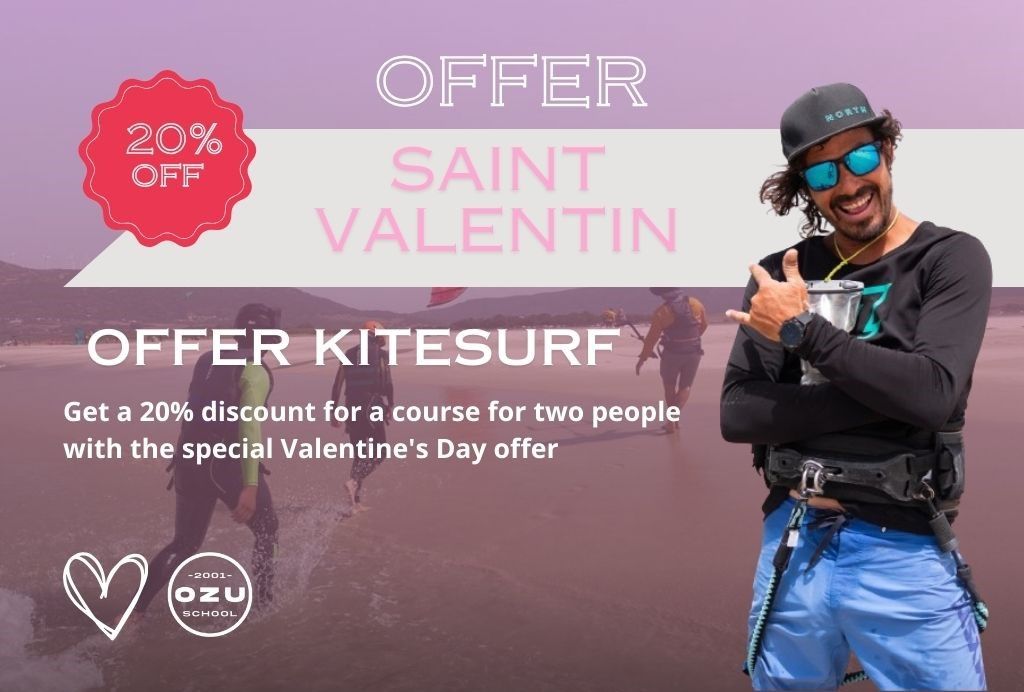This website uses cookies so that we can provide you with the best user experience possible. Cookie information is stored in your browser and performs functions such as recognising you when you return to our website and helping our team to understand which sections of the website you find most interesting and useful.
We answer the most frequently asked questions
We will try to resolve the first doubts that arise when you are interested in booking your kitesurfing or wingfoil course.
You will also find more specific frequently asked questions related to the world of kitesurfing and wingfoil. They are those kinds of questions that begin to arise when you know that you are going to begin the adventure of learning these sports and the excitement takes over!!
We are waiting for you with open arms!
Kitesurf
NO
For those who do not follow or know the safety regulations, kitesurfing can be a very dangerous sport.
Kitesurfing courses are necessary to know well the theoretical bases of how the kite works, the safety measures, and the rules of preference in the water. The worst causes of accidents arise from people trying to learn alone or with the help of an inexperienced person. In addition to being dangerous, it may take a while to evolve to the level of what an instructor can do in a relatively short period.
The most important thing to take into account is the experience and qualifications of the instructors.
Our kitesurfing school renews its material every year and is state-of-the-art, and the rescue boats are attentive to our students who are marked with bright lycra.
In addition, we have civil liability and accident insurance.
It is advisable for the student to bring a swimsuit, sunscreen, water and sunglasses.
We will provide you with the rest: kite, board, neoprene, vest, harness and helmet.
If the wind is not suitable for the course, we will refund the money equivalent to the hours remaining to be taken without any problems.
It is not usually common but if it happens you can rest assured that the money will be returned
At Ozu School we put several options on the table:
- Through the web forms.
- Calling us directly on our cell phone and talking to us.
- via WhatsApp
- In the Ozu Tarifa physical store
The average duration to understand and master the handling of the kite until you can sail in both directions safely (waterstart) ranges between 9 and 15 hours.
This period is subject to your skill and the favorable weather conditions for kiting. It is not directly linked to the person’s physical condition, but rather to coordination and mental disposition.
Yeah! We ask for experience in wind sports for the beginner rental and, in addition to that, experience in foils for renting the complete Wing + Foil package. If you don’t meet that, go through our courses! You will make your life much easier!
-
-
- ¡Sí! Pedimos experiencia en deportes de viento para el alquiler principiante y, además de eso, experiencia en foils para alquiler el pack completo de Wing + Foil. Si no cumples con eso, ¡pasa por nuestros cursos! ¡Te harás la vida mucho más fácil!
-
- ¡Sí! Pedimos experiencia en deportes de viento para el alquiler principiante y, además de eso, experiencia en foils para alquiler el pack completo de Wing + Foil. Si no cumples con eso, ¡pasa por nuestros cursos! ¡Te harás la vida mucho más fácil!
- ¡Sí! Pedimos experiencia en deportes de viento para el alquiler principiante y, además de eso, experiencia en foils para alquiler el pack completo de Wing + Foil. Si no cumples con eso, ¡pasa por nuestros cursos! ¡Te harás la vida mucho más fácil!
Yeah. All official kitesurfing schools in Tarifa have a rescue boat service to assist our students at all times: loss of board, difficulty returning to shore, any damage caused to the equipment.
These companies only provide service in authorized areas (exclusive teaching areas for official schools)
It must be approved by the Spanish sailing federation (Andalusian sailing federation), registered with social security, it must also have accident and civil liability insurance and be registered as an active tourism company.
Tariff kitesurf schools are required to have a contract with the rescue company and license from Tariff town hall.
Wingfoil
Wingfoil has become the new way to enjoy the wind and the sea in recent years.
We leave you a small list of advantages that wingfoil offers over kitesurfing. We are not saying that neither is better than the other, since both offer unique sensations and, each in their own way, they are incredible sports that you become addicted to.
- FREEDOM. Kitesurfing requires specific conditions and an adapted and safe place to launch the kite, so you must be in the right place and have someone to lift your kite. On the other hand, the wingfoil can be mounted and start navigation from practically anywhere, always taking into account the level of the practitioner.
- GREATER WIND RANGE. The advantage of being able to unwind our wing so easily allows us to fly with a 4 meter wing in winds from 12-13 knots to 35 knots.
- SAFETY IN STRONG WIND. With the wingfoil, when a very strong gust hits you, when you release the back hand or both and it loses all the force and you will never be in danger of flying away.
- THE DELICATE AND FLOW. The wing has been created to blend with the foil. Together they give a feeling of fluidity, smooth navigation, tranquility, calm, freedom, it is a navigation that can be super relaxing with light winds…
- IF THE WIND GOES AWAY. If the wind suddenly stops and you are very far from the coast with your kite, you have to try to return with a large piece of equipment and a board that does not float, in addition to knowing self-rescue techniques to prevent the kite from taking you adrift. You’re in real trouble. With the wingfoil you just have to tie or deflate the wing and paddle back.
- DOWNWINDS. The advantage of wingfoil comes with the issue of organization. In kitesurfing, you can do a 15 kilometer downwind, but you will need someone to pick you up upon arrival. The advantage of the wingfoil is that you can do several downwinds in the same session since the foil, having less friction than a board, will allow you to sail upwind with an efficiency that kitesurfing would never imagine.
We explain it to you in a simple way:
The process is usually divided into three days. Every day you will learn new concepts and put into practice the concepts already learned.
Once you have completed the three days of the course, you will be able to do your first pitches but you will not be independent.
1. FIRST DAY – BASIC NOTIONS
On this day we will start with a brief theoretical part. Next, we will learn how to assemble the wing and control it in the sand. We will end up sailing on a large volume Paddle.
2. SECOND DAY – FOIL CONTACT
You will learn how to ride the foil and we will put into practice what we learned in the first class on a specific board for Wingfoil. We will have the first sensations with the foil.
3. THIRD DAY- IMPROVEMENT
We will help you perfect your foil technique, set courses and try your first transitions.
To start in this sport, volume is the key aspect.
More board volume will provide more buoyancy and a foil with more surface area will be more stable once in flight.
Recommended Wingfoil equipment for initiation:
- a 120L board, minimum 6′ (length and width)
- a wing of 5 m2. The size of the wing decreases as the force of the wind increases, while remaining in relation to the weight of the user.
- A foil with a medium mast of about 75 cm and a foil wing of between 2000 and 2500mm2 will facilitate getting out onto the water, in almost flat water, but without much speed.
There is no single inventor of wingfoil, as it is a sport that has evolved through experimentation and the combination of existing technologies in the field of water and wind sports.
But a brief history of the birth of this sport as a concept:
The birth of the Wing Foil took place in Hawaii, where a group of passionate local surfers ventured to experiment with the fusion of an inflatable wing and a foil to cross the waters. The vision behind this innovation was to harness the momentum of the wing to propel the foil and rise above the water, especially in low wind conditions.
The precursor of this aquatic revolution was the surfer Alex Aguera, who ingeniously designed the first wing prototype. After adjustments and refinements, Aguera and his team achieved a walk on the waters, thus discovering the possibilities that were hidden in this new sporting discipline. This maiden voyage marked the beginning of an activity full of emotions and unlimited perspectives.
The danger is minimal with a fairly large foil, not very fast and not very sharp. Safety comes from the choice of material: a board with good buoyancy), practiced close to the shore, on a calm sea, with a weak side wind of 15 to 20 knots, allows you to reach the shore on dry land quickly in case drift, while the land wind tends to push you towards the open sea.
The level of danger is determined by your choice of material and conditions.
- The gear: the larger and slower the foils are, the less sharp they will be and therefore will not be dangerous. On the other hand, with high aspect foils the edge surface tends to be reduced as much as possible to minimize friction in the water and maximize speed. Therefore, with those foils you must be very careful not to hit yourself or to be well protected so as not to suffer cuts or injuries.
- The conditions: if you have any problems on a day with a weak side wind of 15 to 20 knots, it will be much easier for you to reach the shore in case of drift, while the onshore wind tends to push you towards the open sea.
We will provide you with the key information you need to make informed decisions and accelerate your wingfoil progress.
Wingfoil has seen a surge in popularity thanks to advances in hydrofoils. Choosing the right equipment makes a difference in your speed of progression.
Crucial Equipment Details:
- Wing sizes: We recommend starting with a 4 or 5 meter wing, depending on your weight. A typical mistake is being afraid of using a slightly larger wing size that will propel us more. This makes getting on the board and getting off the foil much easier than if you use a slightly smaller wing.
- Hydrofoils: The wing surface affects glide speed and stability. Choose according to your level; The large ones are ideal for beginners (between 2000 and 1200), these will provide great stability on the foil and on the board, but sacrificing a little your maximum speed. On the other hand, smaller wings are more unstable when you are going slow and learning to control the foil but they become more stable when you go faster.
- Mast Length: A length of 70 cm is excellent for learning. Adjust according to your preference between stability and maneuverability. Unlike hydrofoil, masts are more stable when they are shorter, but they reduce maneuverability. For more advanced riders, masts between 85-95cm are recommended.
- Table Considerations: Tables are measured in liters and choosing the right one is crucial. Calculate your weight in kilograms and add 30-40 to obtain proper flotation. Don’t rush to size down; a larger team speeds up progression.
Although wingfoiling may seem effortless, patience and determination are key to mastering the art of flight over water.
A wingfoil kit is made up of the following elements:
- Wing or Ala: as its name indicates, it is similar to a wing, it will be our engine.
- Table: there are different models and sizes depending on the level and conditions of each one. They usually have a thicker structure to provide flotation and stability.
- Foil: the crucial piece of this sport, it consists of a mast (between 75 to 100 cm long) with an airplane-shaped base, which creates lift, allowing the board to rise above the surface of the water. It can be adjusted to control the height at which you fly over the water.
- Helmet and Vest: Although they are not essential, in wingfoil it is highly recommended to be well protected to avoid injuries with the foil.
The cost of a complete wingfoil kit can vary significantly depending on the brand, quality, and whether you are purchasing new or used equipment.
We provide you with a general price range for each major component:
- Wingfoil board: They can cost from around €300-500 to several thousand euros if you buy new boards from the last year, depending on the brand and type of construction.
- Foil: Foils can also vary in price. You can find second-hand options from €500 onwards. And the new options would be on average €1,200-€2,000.
- Wing: you can expect to buy a second-hand one with some use for €300-€400 or if you opt for a new option, wings sell in the range of €800-€12,000 arpox. Depending on the brand and model.
In summary, you can opt for second-hand wingfoil equipment that is around €1000-1200 or new equipment that would be around €3000-4000.
It is advisable, but not mandatory, to have more than one wing or foil size as it will help you get the most out of a greater wind range.
General courses
The most important thing to take into account is the experience and qualifications of the instructors.
Our kitesurfing school renews its material every year and is state-of-the-art, and the rescue boats are attentive to our students who are marked with bright lycra.
In addition, we have civil liability and accident insurance.
It is advisable for the student to bring a swimsuit, sunscreen, water and sunglasses.
We will provide you with the rest: kite, board, neoprene, vest, harness and helmet.
If the wind is not suitable for the course, we will refund the money equivalent to the hours remaining to be taken without any problems.
It is not usually common but if it happens you can rest assured that the money will be returned
At Ozu School we put several options on the table:
- Through the web forms.
- Calling us directly on our cell phone and talking to us.
- via WhatsApp
- In the Ozu Tarifa physical store
Yeah! We ask for experience in wind sports for the beginner rental and, in addition to that, experience in foils for renting the complete Wing + Foil package. If you don’t meet that, go through our courses! You will make your life much easier!
-
-
- ¡Sí! Pedimos experiencia en deportes de viento para el alquiler principiante y, además de eso, experiencia en foils para alquiler el pack completo de Wing + Foil. Si no cumples con eso, ¡pasa por nuestros cursos! ¡Te harás la vida mucho más fácil!
-
- ¡Sí! Pedimos experiencia en deportes de viento para el alquiler principiante y, además de eso, experiencia en foils para alquiler el pack completo de Wing + Foil. Si no cumples con eso, ¡pasa por nuestros cursos! ¡Te harás la vida mucho más fácil!
- ¡Sí! Pedimos experiencia en deportes de viento para el alquiler principiante y, además de eso, experiencia en foils para alquiler el pack completo de Wing + Foil. Si no cumples con eso, ¡pasa por nuestros cursos! ¡Te harás la vida mucho más fácil!
Yeah. All official kitesurfing schools in Tarifa have a rescue boat service to assist our students at all times: loss of board, difficulty returning to shore, any damage caused to the equipment.
These companies only provide service in authorized areas (exclusive teaching areas for official schools)
It must be approved by the Spanish sailing federation (Andalusian sailing federation), registered with social security, it must also have accident and civil liability insurance and be registered as an active tourism company.
Tariff kitesurf schools are required to have a contract with the rescue company and license from Tariff town hall.
Tarifa
Tarifa is a natural environment that offers a multitude of options for all tastes. If you come looking for wind and it turns out that there are days when it does not appear or is not enough, you can enjoy a multitude of activities that will make you have a good time.
Some of the most recommended activities for windless days are:
- Padel Surf Rides – An excellent option for days with calm seas.
- Bike Routes – Tarifa offers many bicycle trails for all levels that run throughout the Alcornocales Natural Park.
- Climbing – Climbing is a sport that is becoming very popular and Tarifa offers a large number of areas for climbing.
- Whale Watching – Through the Strait of Gibraltar there is a large number of cetaceans and in Tarifa there are excursions to see these incredible animals.
- Hiking – There are many options, from mountain trails, coastal trails, or long walks on the beach.
Tarifa is a municipality that is located at the southernmost point of the entire European continent. Located in the community of Andalusia, Tarifa belongs to the province of Cádiz.
One of the many peculiarities of Tarifa is that the town itself separates the Mediterranean Sea from the Atlantic Ocean.











